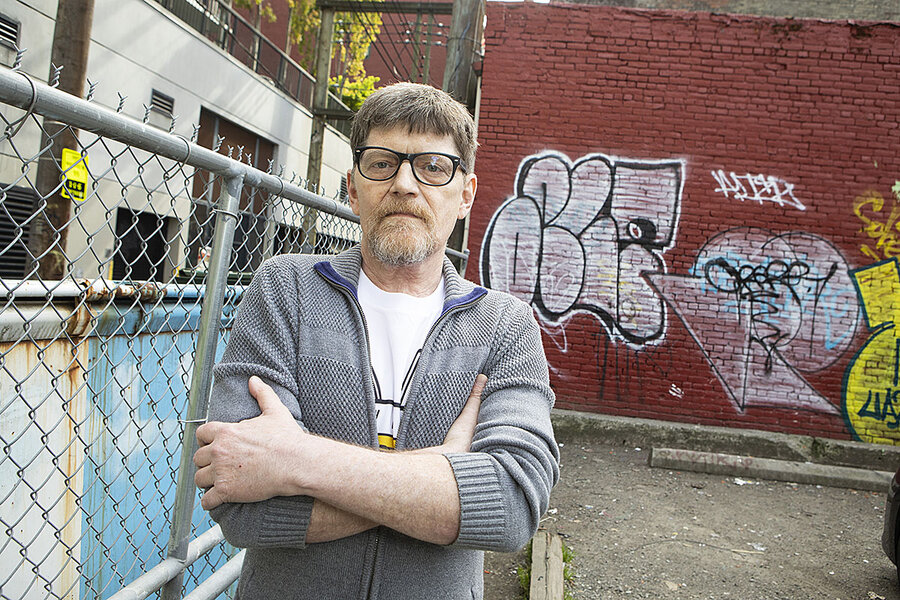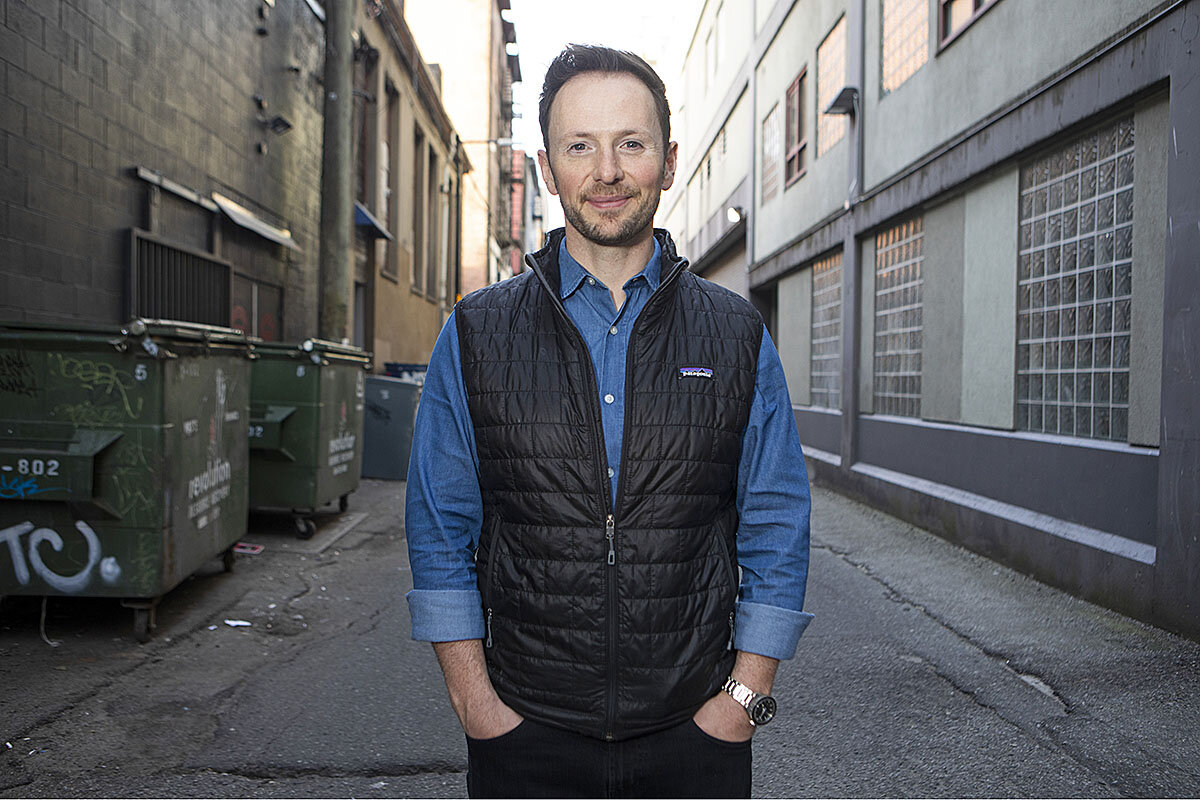‘Crisis of masculinity’: How opioid epidemic hits men harder
Loading...
| Vancouver, British Columbia
Both men and women across North America are dying from fentanyl – a synthetic opioid roughly 50 to 100 times more toxic than morphine that’s entered the drug supply. But when the mortality data has been crunched, the overwhelming number of victims are men, most in the prime of their lives. With fentanyl in the supply, men in the United States have succumbed at a much greater rate than women starting in 2013. In Canada, the disparity is similar.
Now doctors, officials, and social workers in Vancouver are questioning whether the drug crisis is also an overlooked crisis of masculinity. Men take bigger risks with drug use and feel that they can handle their intake. Amid social and economic changes, many men have lost their traditional moorings – making them even more vulnerable in this high-stakes era for drug consumption.
“There seems to be something going on here with men, where some parts of masculinity seem to produce more substance use and more risk of overdose deaths,” says Chris Van Veen, director of strategic initiatives and public health planning at Vancouver Coastal Health. “More men seem to be using these poisoned drugs.”
Why We Wrote This
Ideals of masculinity may be making men more vulnerable to the sort of thinking that leads to fatal overdose. Officials around Vancouver are building their prevention plans around that theory.
On a recent morning in the Downtown Eastside, a man in a parking lot picks up a syringe from the ground. Hoping that it contains some sort of substance, he puts it to his arm. But it is empty. He throws it back down.
It is just one scene in this 10-block Vancouver neighborhood, one of North America’s most concentrated areas of drug injection. And it is increasingly lethal as the opioid fentanyl becomes more common; overdose deaths have skyrocketed in this province by 651% between 2009 and 2018.
But Dean Wilson, who began using heroin in his teens and is now an activist whose focus is on establishing a legal, safe supply, says that the victim tally is mounting from those outside the Downtown Eastside, who neither have the tolerance for the drugs nor the access to have them tested.
Why We Wrote This
Ideals of masculinity may be making men more vulnerable to the sort of thinking that leads to fatal overdose. Officials around Vancouver are building their prevention plans around that theory.
“We’ve realized that a number of the men dying down here aren’t from here,” he says. “They are construction workers; they’ve got jobs. They are anywhere between 20 and say 35, 40 years old. They come down here on Friday night, they cash their checks, they’re having a beer, they grab a paper of down [heroin] to go home with, they snort it at home. They go to bed. They don’t wake up.”
In fact, health officials are now planning intervention specifically for those in the building trades. And as overdose deaths among men now far outstrip those among women, many doctors, officials, and social workers question whether the drug crisis is also an overlooked crisis of masculinity.
Men take bigger risks with drug use and feel that they can handle their intake. Amid social and economic changes, many men have lost their traditional moorings – making them even more vulnerable in this high-stakes era for drug consumption.
“We’ve thought long and hard about how to create services that keep women safe and that address their unique health care needs. But there seems to be something going on here with men, where some parts of masculinity seem to produce more substance use and more risk of overdose deaths. More men seem to be using these poisoned drugs,” says Chris Van Veen, director of strategic initiatives and public health planning at Vancouver Coastal Health.
Men at risk
Both men and women across North America are dying from fentanyl – a synthetic opioid roughly 50 to 100 times more toxic than morphine. But when the mortality data has been crunched, the overwhelming number of victims are men, most in the prime of their lives.
Men have always displayed riskier behaviors with substance use. But with fentanyl, men in the U.S. have succumbed at a much greater rate than women starting in 2013, says Merianne Rose Spencer, a statistician at the Centers for Disease Control and Prevention. In 2011 and 2012, overdose rates between the genders were similar.
Traci Green, associate director of Boston Medical Center’s Injury Prevention Center, says some of it might boil down to less interface with the health system for men. “Women in general across health conditions tend to seek care more, but they’re also surveyed more. ... Women have more health conditions that bring them to a health professional, and each of those is an opportunity to check in,” Dr. Green says.
A lack of opportunities for men, when it comes to general wellness, is what drove Paul Gross, a family doctor in Vancouver, to co-found the “Dudes Club,” a meet-up for men, many indigenous, who have a host of hardships from addiction, to poverty, to homelessness – and who were looking for a place to talk about it. Dr. Gross says that drug use has always been a part of their reality but fentanyl has hit them hard – at one point in 2017 they estimated that they had lost 25% of their members to overdose.
Now the group is creating “squads” to go out to Oppenheimer Park, in the heart of the Downtown Eastside, to try to bring in new members seeking brotherhood. “That relational piece I think is missing in the opioid response,” Dr. Gross says. “There is a whole lot of [anti-overdose drug] Narcan and a whole lot of harm reduction, a whole lot of safe injection sites. But not a lot of engaging people, and connecting them to healthy relationships.”
The most deaths in British Columbia happen in the Downtown Eastside, says Mr. Van Veen. But in Vancouver, half occur outside it. And many of the victims aren’t necessarily addicted to opioids.
In a forthcoming study by Vancouver Coastal Health, just 39% of those who have died around the greater Vancouver and Central Coast region had documented daily opioid use, suggesting that many deaths occurred among those who were not addicted. In a British Columbia Coroners Service report, nearly half of those who overdosed fatally in 2016 and 2017 had jobs. Among those, 55% worked in the trade and transport industries, where workplace injuries are common.
Now Vancouver Coastal Health plans to target those in the building trades in a pilot project, bringing to job sites safety talks about treatment options or teaching workers how to use Naloxone anti-overdose kits. So far employers have been open, says Mr. Van Veen, because of the magnitude of the problem. “This crisis is so widespread in this province now that everybody knows someone or knows someone who knows someone who’s died or had an overdose incident or lost a loved one,” he says.
Putting a gender lens on the issue
Alongside this targeted intervention for men, experts are looking deeper to some of the sociology driving men’s death rates – whether it’s risk-taking or overconfidence that they can handle their drugs.
“Normally if we see disparate statistics leaning the other way, we say there’s a gender dimension to this, and we tend not to do that if it’s men,” says Michael Kaufman, an expert on manhood who wrote “The Time Has Come.”
But he says this is a gender issue that demands dominant ideals of manhood be understood. “One is that from a pretty early age, men are trained not to ask for help. We have these strong images that a real man can ‘go it alone.’ He can look after himself.”
That could be behind statistics in a British Columbia Coroners report in January that show 62% of fatal overdoses of illegally taken drugs occurred in private residences. Across Canada, in the latest federal statistics, 75% of accidental apparent opioid-related deaths occurred among men.
Mr. Kaufman also sees a powerful intersection between the opioid crisis and the economic and social underpinnings in which the traditional “blue collar” worker no longer enjoys the status of the dependable breadwinner as he did for the last century. “What you are seeing is a lack of sense of possibility, a lack of sense of worth,” he says. “What that means is that your own capacity for resilience is reduced.”
Dan Bilsker, a Vancouver psychotherapist who focuses on men’s health, has urged policymakers to put a gender lens on the issue – which in turn can break down barriers.
“The caricature was that these fentanyl overdose deaths were taking place in alleys in the Downtown Eastside. But most of them are taking place in people’s homes,” he says. “You see a guy who’s been working really hard at a dangerous job and got severely injured, and it changes your whole reaction to that situation.”
Therein may lie a solution, he says. “It brings out the tragedy and the loss of it. You can empathize more powerfully. You relate to the person you see.”










